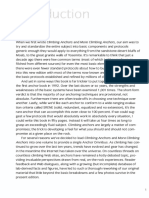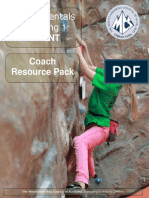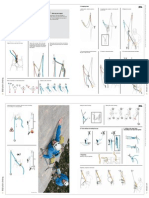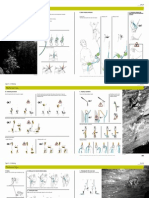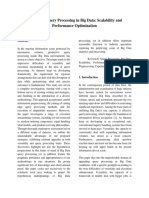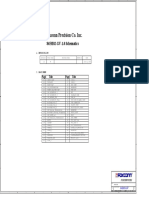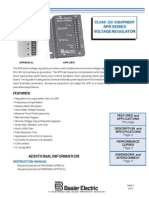Route Setting Manual
Route Setting Manual
Uploaded by
api-268928582Copyright:
Available Formats
Route Setting Manual
Route Setting Manual
Uploaded by
api-268928582Original Title
Copyright
Available Formats
Share this document
Did you find this document useful?
Is this content inappropriate?
Copyright:
Available Formats
Route Setting Manual
Route Setting Manual
Uploaded by
api-268928582Copyright:
Available Formats
Route Setting Manual
General Rules
1. Setters
There must be at least two people present in order to do any setting or stripping.
Picking up regular shifts takes priority over getting scheduled for routesetting.
Only set during your designated setting hours. If youre going to be late, call the
routesetting coordinator to let them know, or else you will receive a write-up.
Clean-up should start at least 15 minutes prior to the end of the setting hours.
Communication with your fellow setters is critical. It allows you to maintain a
thorough perspective of their safety and help them out if needed.
Use A,B,C,D rating system for all 5.10 and above, for 5.9s use + or -\
2. Self-Belay
Tie your first back up knot at 10 feet, and then every 5 feet thereafter.
Make sure to check your knot, harness, Gri-Gri, and rope before you begin.
Make sure you have everything you need before you begin. You dont want to be forced
to come down just because you forgot one bolt.
Make certain your bucket is secure to the rope before pulling it up the wall. Always clip
in and check the handle.
Always bring one daisy chain with you, two is better. These help tremendously on
overhangs.
Use carabineers to secure all your gear to your harness.
Only use double locking carabineers (Carabineers used for top-rope set up) on self-belay.
This is a must. The other carabineers can be used for gear only.
Equipment
1. Helmets
When self-belaying on the wall, you must either be wearing a helmet or have one
attached to your harness.
When setting on the boulder wall, you must have a helmet with you at all times,
and it must be on if someone is self-belaying on a nearby wall.
When walking around the safe-deck, you must be wearing a helmet if someone is
self-belaying on the wall.
2. Ladders
Only use the ladders marked UNT Climbing Wall.
When setting with a ladder, you may not go above 10 feet without self-belaying.
3. Tape
Always brush tape down firmly, so that it doesnt peel off.
Place tape underneath the hold, on the side opposite of the intended foot
placement to ensure the tapes longevity.
Tape in the same direction whenever possible.
Use a noticeably different color of tape than neighboring routes.
Use silver and olive tape only as a last resort. When doing so, draw an obvious,
repeating design in black marker.
Also, avoid using striped tape unless it is absolutely necessary.
When completed, routes must be labeled with a name, setters initials, date set,
lead or top rope, and grade.
Mark any blowouts with a large X of red tape.
4. Bolts
DO NOT CROSS THREAD!!! If it is hard to screw in, then stop and tap it out
with the tap tool.
Use the correct bolt type (regular, martini, button, or extender) and length for the
hold.
If you come across a bad bolt, DO NOT USE IT!!! Instead, put it in the blue bad
bolts bin.
Always bring extra bolts. You can never have too many bolts, but you can definitely run
out at the top.
5. Holds
DO NOT BREAK HOLDS!!! If you tighten a hold too much, it will crack and
break. Holds are a precious commodity, so please dont let this happen.
Feature holds cannot be placed in such a way that they interfere with other routes.
Also, secure the feature with another hold or bolt if theres a chance it could spin.
Make sure you have enough holds; you dont want to run out at the top of a route.
Make sure to use appropriate starting and finish holds.
6. Gri-Gri
Use the Gri-Gri and double locking carabiners (the same we use for our top rope setups)
found in the tall tower for self-belaying. Never use any belay device other than the Gri-
Gri for routesetting.
7. Easy-Daisy
Use these sling devices for safety as well as efficiency while setting. Load the easy-
daisy through your harness like you are tying in to lead climb. Then, girth hitch it
around the tie-in point and clip a carabineer through the rated loop at the end of the
sling.
Use the easy-daisy to pull yourself closer to a work area by clipping the carabineer into
the bolts where the quickdraws are hanging on the wall. Cinch the sling toward you,
eliminating the space and pulling your closer to the wall.
8. Wrench, Ratchet, and Drill
When setting, only use the wrench to put holds on the wall. Never use the ratchet or
drill to accomplish this. With the drill and ratchet, you might over-torque the holds,
causing a blowout or causing the hold to break.
Feel free to use the ratchet and/or drill while stripping.
DO NOT OVER-TIGHTEN BOLTS!!!
9. Tap tool
If you suspect a t-nut is cross-threaded, use the tap tool.
Slowly screw the tap into the t-nut until you have effectively smoothed out the threads.
Dont force the tap in the t-nut, as this could break the taps head.
10. Buckets and Bags
While setting, use the buckets and bags to carry holds up or remove them from the
wall. Use the route-setting carabineers to clip a bucket or bag to the belay loop on your
harness.
Its a good idea to use an adjacent rope to haul a bucket up and down the tower for
stripping routes, whereas you would clip a bag to your harness for setting.
Make sure the bottom of the bucket is not damaged before use.
Stripping Routes
Start stripping from the top of the wall, working your way down for maximum
efficiency.
Dont overfill your bag or bucket when stripping.
Leave holds on the wall if theyre double-taped and part of another route.
All dirty holds must be placed in the dirty holds bin. If they havent been
cleaned, they cannot be put on the wall.
Setting routes/ Setting theory
Come into setting with thought out idea in mind. This is a must; Think about
moves the night before or the day before. Look at your canvas, and have a plan.
Picking holds.
o Pick appropriate holds for where you are setting on the wall. For example
a 5.9 on the overhang will use different holds than a 5.9 on the slab. The
overhang will need juggy holds with some technical moves and the slab
will need semi-difficult holds with more technical moves. Be aware!
o There are multiple possibilities, do what works best for you. Here are a
couple of options:
Pick out all of your holds and select bolts. Tape the bolts in over
the bolt-hole with your selected tape.
Pick out all of your holds and select bolts. Do not tape bolts in.
Doing it this way, you could loose bolts in the bag so always bring
more than enough bolts with you so you can replace a bolt if it has
fallen out.
Start at the bottom of the wall with your start hold and set the first couple
sequences of moves with the latter, this will help save time.
o The start hold should be taped with a V but not until the route is
completely finished.
Think out a sequence before you start setting the sequence (This goes along with
having a plan before you come in, but things dont always go according to plan).
For example: Think out five feet of moves, set the moves and try them out. If they
work, MOVE ON. You dont want to waste time trying the same sequence over
and over if you know it works. If you have time at the end you can tweek what
you dont like.
Once you get to the top, set an appropriate finish hold and tape a square around it.
NEVER END ON THE TOP OF THE WALL, use a hold at the top.
A MUST: when coming down from the route, brush ALL tape.
Clean up:
o Put away all necessary equipment used.
o Organize bolts and extra holds used to appropriate bins.
Extras:
o If you arent finished with a route at the end of a setting period ( only
acceptable if you are new to setting, setting in the cave, or setting a 5.12.)
you are aloud to keep your selected holds. Otherwise, NEVER STASH
HOLDS.
Route Documentation
1. Route Database- Helps us keep track of what routes are up and what routes need to come
down.
Located in the OPC folder on the computersClimbing wallRoute settingRoute
Database!
Setters must use the database for both big wall and bouldering routes. Bouldering should
not be neglected!
Setters should put their newly set route in the database with the following information:
o Appropriate grade
o Appropriate tape color
o Date set
o Setter Initials
o Lead/ Top Rope or Both (Not for bouldering routes)
Always SAVE.
Setters have one week to put their route in the database after set
DELETE route out of database when stripped. IMMEDIATELY.
2. Route Feedback Binder- Gives our participants a chance to give us feedback on all the routes
set at the wall.
Located in the cabinet with desk materials at the climbing wall or on the desk during wall
hours.
Setters must make a new entry immediately after finishing a route.
o Paper is located in the cabinet with orientation papers
The Entry should include:
o Setters Name
o Route Name
o Three route grades: Setters grade in the middle, then closest grade up and down.
Example:
5.9+ 5.10a 5.10b
Take Route out of feedback binder when it is stripped. If there is feedback
give it to the setter.
Setting Safe Routes
The climb cannot traverse under another belay bar at any point.
Holds cannot be placed so that a bolt/quickdraw interferes with a move.
The line of your route must be safe from dangerous falls, pendulums, artes, faces, etc.
Lead climbs must have a safe and logical clipping line; they cannot be runout.
If the route is lead-able, make sure it runs close enough to the quick draws that
its safe for the climbers. CLIPPING SHOULD NOT BE THE CRUX.
Remember that THE second CLIP IS THE MOST DANGEROUS. The
potential to deck is greater here than at any other point. All routes should
allow for a solid and comfortable second clip.
The crux of a lead climb should be above the 3
rd
or 4
th
clip.
In order to safely clip the anchors, lead climbs must finish on a good, positive
hold.
The climb must be tested and marked as TR/Lead, Toprope Only or Lead Only.
NEVER end on top of the wall unless youre setting on the bouldering wall.
Use a finishing hold.
Setting Creative Routes
Set routes that stress climbing fundamentals rather than setting ladders. If you
set a ladder, the routesetting coordinator will make you change it!
Be creative! Incorporate liebacks, backsteps, matches, flagging, underclings,
sidepulls, jump-starts, dynos, naturals, feature holds, volumes, and other
interesting things into your routes so that theyre entertaining and educational.
Avoid setting one-move wonders as much as possible. Consistent routes are
fun to climb again and again.
Try to use the elbow rule for the majority of your setting.
Your routes should FLOW. If its awkward, then CHANGE IT!
Making Your Grade
When you are assigned a grade, it is essential that the grade is met.
It must be within one letter grade. The route setting coordinator (based on a
general consensus) will decide the true grade.
If you miss your grade, there will be consequences.
You might also like
- One Move Too ManyDocument117 pagesOne Move Too ManyMZ100% (3)
- Eric Hörst - The Rock Climber's Exercise Guide (2016)Document257 pagesEric Hörst - The Rock Climber's Exercise Guide (2016)charlesNo ratings yet
- Self-Coached Climber - The Guide To Movem - Dan M (1) HagueDocument376 pagesSelf-Coached Climber - The Guide To Movem - Dan M (1) HagueBill Frisch100% (2)
- Hörst E. - Training For Climbing (2016)Document621 pagesHörst E. - Training For Climbing (2016)Christian Villarreal100% (4)
- Higher Education (Andy Kirkpatrick) (Z-Library)Document901 pagesHigher Education (Andy Kirkpatrick) (Z-Library)explorando.los.andesNo ratings yet
- Croatia Bouldering GuideDocument145 pagesCroatia Bouldering GuideNika-Kentauri Serendipitous100% (1)
- Rock Climbing - Mastering Basic - Luebben, Craig PDFDocument549 pagesRock Climbing - Mastering Basic - Luebben, Craig PDFTomnatic100% (13)
- John Long, Bob Gaines-Climbing Anchors, 2nd Edition-FalconGuides (2006) PDFDocument233 pagesJohn Long, Bob Gaines-Climbing Anchors, 2nd Edition-FalconGuides (2006) PDFMariano A. Medina67% (3)
- VDiff TradClimbingBasics E Book June2019 PDFDocument187 pagesVDiff TradClimbingBasics E Book June2019 PDFMichał SzymusiakNo ratings yet
- Catalyst At-Home Training Plan Reference Document 1.1 PDFDocument18 pagesCatalyst At-Home Training Plan Reference Document 1.1 PDFmarcos jimenezNo ratings yet
- Down-Thecompletedescentmanual Andy KirkpatrickDocument902 pagesDown-Thecompletedescentmanual Andy KirkpatrickSinziana GhinetNo ratings yet
- Rock Climbing 6 Week Workout Plan - Adventure SchoolDocument21 pagesRock Climbing 6 Week Workout Plan - Adventure SchoolYusuf TosunNo ratings yet
- VDiff TheTradClimbersGuideToProblemSolving E Book June2019 PDFDocument157 pagesVDiff TheTradClimbersGuideToProblemSolving E Book June2019 PDFMichał SzymusiakNo ratings yet
- Rock Climbing Anchors The Mountaineers-Luebben CraigDocument374 pagesRock Climbing Anchors The Mountaineers-Luebben CraigNedelea Ilie100% (1)
- Asics Trainingplans Sub 4.30 PDFDocument4 pagesAsics Trainingplans Sub 4.30 PDFSpeter DanNo ratings yet
- Rock Climbing Mastering Basic Skills M - Luebben CDocument278 pagesRock Climbing Mastering Basic Skills M - Luebben CDaniel Gonzalez Losada100% (1)
- Climbing Anchors - Field Guide PDFDocument169 pagesClimbing Anchors - Field Guide PDFThiago Flores100% (2)
- Climbing WorkoutsDocument59 pagesClimbing WorkoutsAlexandre Santos100% (8)
- Sport Climbing Basics - VDiff ClimbingDocument17 pagesSport Climbing Basics - VDiff ClimbingVDiff Climbing100% (1)
- 9 of 10 Climbers Make The Same Mistake - MacLeodDocument88 pages9 of 10 Climbers Make The Same Mistake - MacLeodMali Chovjek33% (3)
- Vertical LimitDocument52 pagesVertical LimitMZNo ratings yet
- How To Big Wall ClimbDocument56 pagesHow To Big Wall ClimbMZ75% (4)
- 3 Point Anchor With CordletteDocument8 pages3 Point Anchor With CordlettelindzmcleodNo ratings yet
- VDiff SportClimbingBasics E Book June2019 PDFDocument117 pagesVDiff SportClimbingBasics E Book June2019 PDFDye Yuan100% (1)
- Rock Climbing Basics - VDiff ClimbingDocument13 pagesRock Climbing Basics - VDiff ClimbingVDiff ClimbingNo ratings yet
- Traditional Lead Climbing: A Rock Climber's Guide to Taking the Sharp End of the RopeFrom EverandTraditional Lead Climbing: A Rock Climber's Guide to Taking the Sharp End of the RopeRating: 4.5 out of 5 stars4.5/5 (3)
- Gothic DystopiaDocument276 pagesGothic Dystopiablackpetal1No ratings yet
- Negros Oriental Provincial SituationerDocument74 pagesNegros Oriental Provincial SituationerDAR PBDDNo ratings yet
- An Ultimate Guide to Bouldering: Accessories, Equipment, Shoes, Tips, Gear, Essentials & MoreFrom EverandAn Ultimate Guide to Bouldering: Accessories, Equipment, Shoes, Tips, Gear, Essentials & MoreNo ratings yet
- The Complete Guide to Bouldering: Beginners, Shoes, Grades, Walls, Tips, Gear, Accessories, & MoreFrom EverandThe Complete Guide to Bouldering: Beginners, Shoes, Grades, Walls, Tips, Gear, Accessories, & MoreNo ratings yet
- Emergency Roping and Bouldering: Survival Roping, Rock-Climbing, and Knot Tying: Survival FitnessFrom EverandEmergency Roping and Bouldering: Survival Roping, Rock-Climbing, and Knot Tying: Survival FitnessNo ratings yet
- Stamina Booster Program Bonus GuidebookDocument20 pagesStamina Booster Program Bonus GuidebookBrian BeauchampNo ratings yet
- Progressive Training Edition 3Document25 pagesProgressive Training Edition 3Brian BeauchampNo ratings yet
- Systematic Movement Training Edition 3Document15 pagesSystematic Movement Training Edition 3Brian Beauchamp100% (1)
- 10 Must Do Exercises4Climbers by Horst0122 Print A0b1c808 f8c8 4672 A358 5bf5e5fe6bfbDocument26 pages10 Must Do Exercises4Climbers by Horst0122 Print A0b1c808 f8c8 4672 A358 5bf5e5fe6bfbRazvan HoteaNo ratings yet
- Speed Climbing 2nd How To Climb Faster and Better How To Climb SeriesDocument169 pagesSpeed Climbing 2nd How To Climb Faster and Better How To Climb Seriesintegrator123100% (1)
- Mastering The Fingerboard Edition2Document16 pagesMastering The Fingerboard Edition2Brian BeauchampNo ratings yet
- Coaching ClimbingDocument55 pagesCoaching Climbinggusperreas7280100% (1)
- 21-07.08 ClimberDocument84 pages21-07.08 ClimberpacoNo ratings yet
- Eric Hörst's Training For Climbing Program: Antagonist and Stabilizer Training Exercises Core Training ExerciseDocument30 pagesEric Hörst's Training For Climbing Program: Antagonist and Stabilizer Training Exercises Core Training ExerciseTodorNo ratings yet
- Technical Tips Climbing MagazineDocument229 pagesTechnical Tips Climbing MagazineelatanorNo ratings yet
- Rock-Climbing-Coaching-Resources FUNdamentalsDocument108 pagesRock-Climbing-Coaching-Resources FUNdamentalsKwstas GiannopoulosNo ratings yet
- Trad Climbing Basics - VDiff ClimbingDocument16 pagesTrad Climbing Basics - VDiff ClimbingVDiff ClimbingNo ratings yet
- Soloist ManualDocument14 pagesSoloist ManualAballéa ChristopheNo ratings yet
- Tech Tips Multi Pitch ClimbingDocument2 pagesTech Tips Multi Pitch ClimbingTomnatic100% (3)
- Metolius - Hangboard, Campus, PeriodizationDocument16 pagesMetolius - Hangboard, Campus, PeriodizationjojobagginsNo ratings yet
- Cam BookDocument32 pagesCam BookWawaNo ratings yet
- Climbing Workouts Bonus ChartsDocument41 pagesClimbing Workouts Bonus ChartsJordy Schep100% (2)
- Training For Climbing PDFDocument216 pagesTraining For Climbing PDFAndrea89% (9)
- Climbing GuideDocument20 pagesClimbing GuideWiryanto Chandra100% (4)
- How To Climb HarderDocument24 pagesHow To Climb HarderIvanNo ratings yet
- Redpoint: The Self-Coached Climber's Guide to Redpoint and On-Site ClimbingFrom EverandRedpoint: The Self-Coached Climber's Guide to Redpoint and On-Site ClimbingNo ratings yet
- T4C Intermediate ProgramDocument28 pagesT4C Intermediate ProgramTina Dinh100% (1)
- Лазание в зале PDFDocument211 pagesЛазание в зале PDFNickolayNo ratings yet
- BMC Climbing OutsideDocument32 pagesBMC Climbing OutsideTyler BellNo ratings yet
- MountaineeringDocument248 pagesMountaineeringOxony20100% (2)
- The Science of Climbing Training: An evidence-based guide to improving your climbing performanceFrom EverandThe Science of Climbing Training: An evidence-based guide to improving your climbing performanceNo ratings yet
- Climbing EssentialsDocument41 pagesClimbing EssentialsTimothy Popik100% (1)
- (How To Climb Series) John Long - Peter Croft - The Trad Climber's Bible-FalconGuides (2014)Document409 pages(How To Climb Series) John Long - Peter Croft - The Trad Climber's Bible-FalconGuides (2014)Tiago Oliveira BaldassoNo ratings yet
- Sport Climbing - Technical Tips PDFDocument3 pagesSport Climbing - Technical Tips PDFNasciturus666No ratings yet
- Boulder Ing For BeginnersDocument42 pagesBoulder Ing For BeginnersednarobertaNo ratings yet
- The Climbing Bible: Technical, physical and mental training for rock climbingFrom EverandThe Climbing Bible: Technical, physical and mental training for rock climbingRating: 4 out of 5 stars4/5 (2)
- Cam Clay PDFDocument9 pagesCam Clay PDFAUSTIN ZHANGNo ratings yet
- Enhancing Query Processing in Big Data Scalability and Performance OptimizationDocument12 pagesEnhancing Query Processing in Big Data Scalability and Performance OptimizationAJAY RNo ratings yet
- Renard HJ 20092Document1 pageRenard HJ 20092YannickNo ratings yet
- FOrmat of BAltic QuestionnaireDocument7 pagesFOrmat of BAltic QuestionnaireNingkhanngam RUivahNo ratings yet
- Ihs Kingdom Hot Keys ReferenceDocument1 pageIhs Kingdom Hot Keys ReferenceMuhammad Jahangir100% (1)
- Foxconn Precision Co. Inc.: 845M02-GV-1.0 SchematicsDocument49 pagesFoxconn Precision Co. Inc.: 845M02-GV-1.0 SchematicsNicu LiviuNo ratings yet
- Ibanez DL5 ModsDocument3 pagesIbanez DL5 ModsDany JkNo ratings yet
- 2017 EMC Testing Guide: Presented byDocument49 pages2017 EMC Testing Guide: Presented bytaha hashmiNo ratings yet
- 1875axxxxxx enDocument4 pages1875axxxxxx engnunezisventecNo ratings yet
- Volume 1 Tender & Contract ConditionsDocument104 pagesVolume 1 Tender & Contract ConditionsShakeelKhanNo ratings yet
- 1.clinical Decision MakingDocument5 pages1.clinical Decision MakingRoshin Mae E. TejeroNo ratings yet
- Starlight 6 OGE Book PDFDocument106 pagesStarlight 6 OGE Book PDFToufik TailebNo ratings yet
- CholeraDocument24 pagesCholeraLavanya Sivakumar100% (1)
- Group 5 Stakeholder AnalysisDocument8 pagesGroup 5 Stakeholder AnalysisRoselyn AcbangNo ratings yet
- Imporatance of Biology in Petroleum EngineeringDocument1 pageImporatance of Biology in Petroleum EngineeringSana NgaNo ratings yet
- True Dragon ListDocument5 pagesTrue Dragon ListBobNo ratings yet
- Evening Street Review Number 40Document250 pagesEvening Street Review Number 40Barbara BergmannNo ratings yet
- S-Band Magnetron: Technical InformationDocument2 pagesS-Band Magnetron: Technical InformationMariosNo ratings yet
- TBT 13-15 Sep 2022 Prevention of Falling ObjectsDocument1 pageTBT 13-15 Sep 2022 Prevention of Falling ObjectsSiraj UddinNo ratings yet
- EXPERIMENTAL-RESEARCH-BIOPLASTIC-12-ABM-PDF (1)Document11 pagesEXPERIMENTAL-RESEARCH-BIOPLASTIC-12-ABM-PDF (1)hannahamodia74No ratings yet
- APR125 5 APR63 5 Basler ElectricDocument4 pagesAPR125 5 APR63 5 Basler ElectricAlvaro H Romero100% (1)
- Photocopiables ST A NEADocument16 pagesPhotocopiables ST A NEADébora Ivone del Milagro PalaciosNo ratings yet
- Exam 1 Chemistry 1140A Fall 2019 Name - (1pt)Document6 pagesExam 1 Chemistry 1140A Fall 2019 Name - (1pt)hamiltonj_866440No ratings yet
- Risk Assessment and ManagementDocument52 pagesRisk Assessment and Managementishtidu34100% (1)
- East Palestine Derailment: Timeline of Key Events in Toxic Train DisasterDocument11 pagesEast Palestine Derailment: Timeline of Key Events in Toxic Train Disasterhamza aslamNo ratings yet
- Identification of Possible Micro Technology and Artificial PatternsDocument34 pagesIdentification of Possible Micro Technology and Artificial Patternsjdml90ps3No ratings yet
- Jurnal 4Document4 pagesJurnal 4Dzaenap UlfahNo ratings yet







